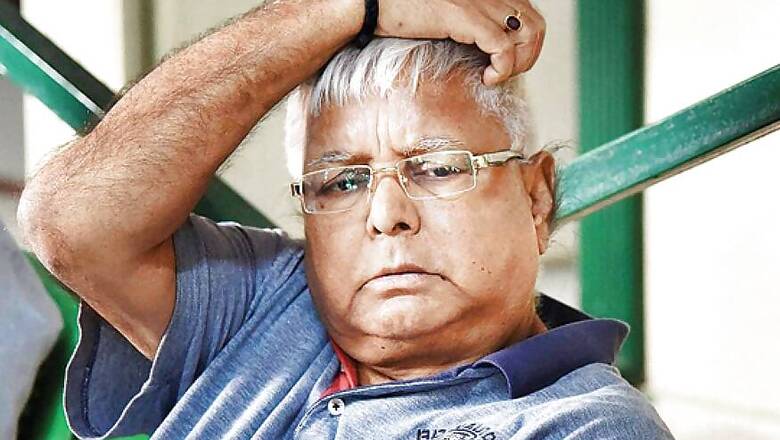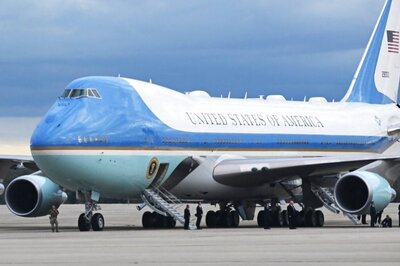
views
Patna: The infamous fodder scam of the early 1990s, for which former Bihar chief minister Lalu Prasad Yadav is currently undergoing imprisonment, has once again been brought to the spotlight after the Nitish Kumar government revealed that a sum of Rs 658 crore could not yet be ratified by the state legislature as the cases are pending with the CBI courts in Ranchi and Patna.
The state government made the revelation during a discussion in the monsoon session of the Bihar legislature on the Excess Expenditure Appropriation Bill, 2019 for ratification of total excessive expenditure during different periods from the financial year 1977-78 to 2015-16.
The misappropriation of funds of the state’s innocuous animal husbandry department is certainly staggering enough, but it is the ingenuity with which the money was siphoned off that is completely breathtaking and unbelievable.
Sample this: altogether 49,950 litres of mustard oil was purchased at the cost of Rs 16 lakh from 1990-91 to 1995-96 for polishing horns of buffaloes in Bihar (including present day Jharkhand). The then manager of the Hotwar milk supply-cum-dairy farm, Dr Januel Bhengraj, produced fake bills to gobble up the money in league with senior officers and top politicians.
Fodder worth Rs 253.33 crore was purchased for the consumption of 959 sheep, 5664 pigs, 40,504 hens and 1,577 goats for Ranchi, Chaibasa, Dumka, Jamshedpur, Gumla and Patna districts against the precise requirement of fodder worth Rs 10.53 crore.
As per the standard procedure, 10 per cent yellow maize is mixed with other ingredients as complete fodder for lactating and meat-producing animals. But yellow maize weighing 115 times more than the required quantity for six districts was shown to have been procured at the cost of Rs 154.72 crore.
Similarly, 15 per cent almond oil cakes are mixed in complete food supplement for animals. However, oil cakes weighing 33 times more than the requirement were shown to have been purchased at the cost of Rs 7.69 crore.
These are fresh revelations related to the fodder scam, made by Bihar deputy chief minister and finance minister Sushil Kumar Modi during the discussion on the Excess Expenditure Appropriation Bill, 2019 in the state legislature.
He said excessive expenditures perceived or necessitated by the government are taken either as advance from the state contingency fund or through supplementary budgets approved by the state legislature.
“But this practice was not followed by the then government led by Lalu Prasad Yadav and excessive withdrawals were made more than the budgetary allocations in a bid to loot the public fund through fake bills,” Sushil Modi said.
A total excess expense of more than Rs 142.47 crore, incurred by different departments during different periods between the financial year 1977-78 and 2015-16, were ratified by the state assembly.
However, a sum of Rs 658 crore spent by the animal husbandry department could not be considered because the fodder scam cases are pending with the CBI courts in Ranchi and Patna.
A close scrutiny of annual outlays of the animal husbandry department reveals a shoddy tale of organised loot through gradual increase of budgetary allocations after 1990 and reckless excessive withdrawals were made through forged bills.
A sum of Rs 54.92 crore was earmarked for animal husbandry department for 1990-91 state budget, but Rs 22.29 crore was spent in excess of budget outlay for the department spending total Rs 84.21 crore during the period.
Similarly, a sum of Rs 59.10 crore was allocated for the department during 1991-92, but instead a sum of Rs 129.82 crore was spent, thus exceeding the budget outlay by Rs 70.72 crore. In 1992-93, the budgetary allocation was Rs 66.93 crore but a sum of Rs 154.70 crore was spent in excess of Rs 87.77 crore.
The budget outlay of the AHD in 1993-94 was Rs 74.40 crore but an astounding Rs 245.01 crore was spent registering excessive withdrawal of Rs 170.61 crore. In 1995-96, the department made an expenditure of Rs 205.06 crore against the budgetary allocation of Rs 82.12 crore showing excessive withdrawal of Rs 122.94 crore.
For over 14 years, the politicians and bureaucrats in Bihar joined hands to craft a spectacular scam. It is well-known that receipts for fodder were conjured out of thin air to the extent that bulls were shown to have been ferried from Ranchi to Ghagra on a scooter. In another instance, a car bearing registration number BHV-5777 was used to carry four bulls from Ranchi to Jhinkapani, according to CAG records.
The government money was systematically looted and imaginary cows and bulls were transported to imaginary farmers who existed only on paper. The rush to withdraw money from the government treasury was so great that the political masters presided over the loot through a nexus of gung-ho bureaucrats and suppliers willing to manufacture bills out of thin air.
The ever-willing treasury officers did not object to excess withdrawals since they also connived with the fodder mafia for pecuniary gains. By January 1995-96, Rs 116 crore were disbursed by various treasuries against the budgetary allocation of Rs 71 crore but the finance department had no clue as to how much money had been overdrawn from treasuries of Bihar.
The money withdrawn on fake bills was stashed away in different banks in benami accounts in connivance with bank officials. In January 1996, the Ranchi administration seized seven bank accounts in different branches of Union Bank of India and State Bank of India. Five out of seven were benami accounts.
Most members of the mafia owned palatial buildings in Ranchi, Patna, Mumbai, Bangalore, Delhi and Kolkata, and it is said that a majority of buildings in Ashok Nagar in Ranchi are owned by fodder mafia and suppliers. All the buildings had black polished marbles fittings and the washrooms had huge lotus-shaped bath tubs which Bollywood stars and starlets used at times as guests.
(The author is a senior journalist.)



















Comments
0 comment